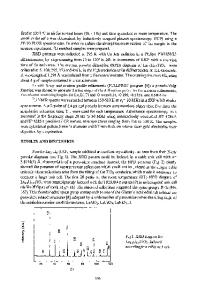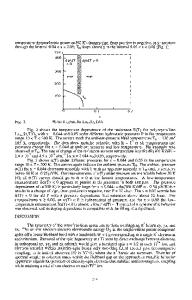Li motion mechanisms in (Li,Na) 3x La 2/3-x TiO 3 (x = 0.067 and 0.167) series followed by ND, NMR and Impedance spectro
- PDF / 401,838 Bytes
- 6 Pages / 612 x 792 pts (letter) Page_size
- 15 Downloads / 299 Views
Li motion mechanisms in (Li,Na)3xLa2/3-xTiO3 (x = 0.067 and 0.167) series followed by ND, NMR and Impedance spectroscopy. A. Varez&, A. Rivera*, W. Bucheli#, R. Jimenez#, and J. Sanz#. &
Dpto. de Materiales, IAAB, Universidad Carlos III de Madrid, 28911 Leganés. Madrid. Spain Dpto. de Física de Materiales, Universidad Complutense de Madrid, 28040 Madrid, Spain. # Instituto Ciencia de Materiales de Madrid, Consejo Superior de Investigaciones Científicas, ICMM-CSIC, Cantoblanco 28049. Madrid. Spain. *
Abstract The dependence of Li mobility on structure and composition of quenched Li0.5-xNax La0.5TiO3 (0 ≤ x < 0.5) and slowly cooled Li0.2-xNaxLa0.6TiO3 (0 ≤ x < 0.2) perovskite series, has been investigated by means of Neutron Diffraction (ND), Nuclear Magnetic Resonance (NMR) and Impedance Spectroscopy (IS). The first series displays rhombohedral (√2ap, √2ap, 2√3ap; S.G. R-3c) symmetry and vacancies are randomly distributed on A-sites (disordered phases), while Li0.2-xNaxLa0.6TiO3 series, presents orthorhombic unit cells (2ap, 2ap, 2ap; S.G. Cmmm) and the vacancies are preferentially located in alternating layers along the c-axis (ordered phases). In both cases, Li ions are shifted from A sites to a fourfold coordination at unit cell faces of the single cubic perovskite and octahedral are tilted along the rombohedral axis in Li-rich and along b-axis in Li- poor series. By heating the elimination of the octahedral tilting takes place changing the symmetry from rhombohedral to cubic in Li-rich samples, and from orthorhombic to tetragonal in Li-poor samples; however no changes were detected in La-vacancy distributions. For a particular value of sodium content (x=0.3 for Li0.5-xNaxLa0.5TiO3 and x=0.17 for Li0.2xNaxLa0.6TiO3), the conductivity drops several orders of magnitude indicating that the amount of vacancies approaches the percolation threshold. In the temperature range 77-500 K, conductivity of Na-doped samples displays departures from the Arrhenius behavior, decreasing activation energy from 0.37 to 0.25 eV in disordered samples and from 0.37 to 0.12 eV in ordered ones. The structural sites occupancy has been investigated by ND, while Li mobility was evaluated through NMR and Impedance spectroscopy. The temperature dependence of thermal BLi factors has been related to the increment of conductivity that precede structural transformations, suggesting that Li motion trigger detected transitions in both series. Introduction The interest on Li3xLa2/3-xTiO3 (0 ≤ x < 0.17), displaying high lithium conductivity (10-3 S/cm at 300K)1 has increased because their possible application as solid electrolytes and electrodes in electrochemical devices. Although many studies have been reported in these perovskites2, there are some aspects related with lithium motion mechanisms that remain poorly understood. Several points are considered important to understand Li conductivity of these materials, namely:(i) the fourfold coordination of lithium at unit cell faces of the perovskite3; (ii) the octahedral tilting that restraint long r
Data Loading...










